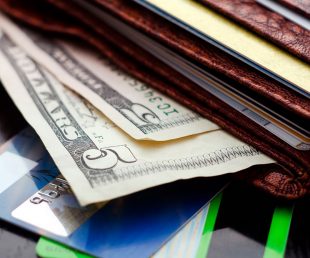While it may feel like small choices in your closet don’t make a big difference, that’s far from the case. Our clothing habits can have a detrimental effect on the planet. Water use, waste, and emissions are major considerations for eco-conscious fashion consumers and investors. Here’s a look at what you can do to become a more eco-friendly consumer while building your ideal wardrobe and portfolio.
Becoming an eco-conscious clothing consumer
There are several ways to make sure you are investing in environmentally friendly clothing. First, you can make the personal choice to invest in higher-quality, long-lasting clothing items, meaning less production and less going to a landfill. Churning through seasonal styles with fast fashion may be fun and affordable, but it can have a harmful effect on the environment.
A single pair of jeans takes about 2,000 gallons of water to produce. The fashion industry uses enough water annually to meet the needs of 5 million people, according to United Nations.1 Another report shares that the fashion industry is responsible for up to 8% of global carbon emissions, and textiles are the source of 9% of microplastic losses to the ocean.2
While sustainability may have you thinking about the latest hip startup, some older fashion brands are making a new name for themselves in sustainability circles. For example, Levi Strauss, the maker of Levi’s Jeans, took steps to eliminate harmful chemicals known as PFAS from its entire supply chain. Levi’s earned the highest Natural Resources Defense Council (NRDC) ranking in its apparel ratings. The NRDC is a nonprofit with a strong environmental-protection mission.
Investing in eco-friendly clothing companies
You can also invest your dollars in sustainable clothing stocks that may be beneficial for both your portfolio and the planet. According to research from Morningstar, stocks with high ratings for ESG (environment, sustainability, and governance) outperform stocks with a bigger environmental impact risk.3
To put your values in your portfolio, you can search for eco-friendly stocks in the fashion world. There’s a growing list of manufacturers and retailers for environmentally conscious investors focused on building a sustainable portfolio.
Victoria’s Secret & Co. was another high-ranking stock on the NRDC scorecard.4 Deckers Outdoor Corp, the owner of brands including Teva and Ugg, also scored well. While there’s no guarantee that an investment will perform well because it is environmentally friendly, it certainly doesn’t hurt.
Also, remember that many smaller companies and startups use eco-friendly practices (and fair wages for employees) and may not be big enough to land on a large list of eco-friendly businesses. Supporting small to midsize businesses with a focus on the planet can help those companies grow to reach more consumers. When eco-friendly clothing manufacturers succeed, they can play a growing role in the overall clothing marketplace, hopefully edging out less sustainable products.
Finding eco-friendly fashion with quality over quantity
When investing in your wardrobe, you are less worried about the company’s financial performance and more about clothing quality. However, it’s an investment all the same, as buying high-quality, eco-friendly clothing today could help you avoid spending money on replacements. The longer something lasts, which doesn’t always require a higher price tag, the longer you can go without spending more on a similar item.
In addition to quality items that last a long time, you’ll want to look into sourcing practices and materials. Many brands are moving away from plastics and unsustainable materials while adding a focus on renewables. With countless clothing brands on the market, here are some things to think about when determining whether a brand makes the planet a priority:
- Materials: First, what is clothing made out of? If you’re seriously concerned about sustainability in your wardrobe, you may have to spend more time looking into the company’s material choices. Companies with eco-friendly materials are usually happy to share that information on their website. Common sustainable materials include organic and recycled cotton, hemp, linen, and cork. Wool, cashmere, silk, down, conventional cotton, and camel-sourced materials may also be derived using eco-friendly practices. If you’re not careful, you could end up with toxic clothing that’s not good for the environment.
- Sourcing and manufacturing practices: Even if the material is potentially sustainable, it doesn’t mean it comes from a sustainable source or uses clean production practices. Again, most companies with sustainable and eco-friendly sourcing are happy to share that information online, so it’s easy to find if a brand is at least paying lip service to eco-friendly practices. Water use, waste management, logistics, and avoiding toxic materials and chemicals are all contributors to the company’s environmental impact.
- Company mission and goals: If a company is serious about protecting the planet, it may say so in its mission statement or website about page.
- Third-party evaluation and research: To do even more due diligence, you can look to outside resources, like the NRDC report mentioned above, on dangerous chemicals in fashion brands.
Several nonprofits offer free information and resources to help you make the best decisions when shopping for new clothing. You may also find news about eco-friendly clothing brands, such as this article from the Wall Street Journal.
Your clothing and investment choices make a difference
From your investment portfolio to your wardrobe, Every small decision adds up. But that doesn’t mean you should eliminate everything that doesn’t meet your new sustainability strategy. It’s best to keep any clothes as long as possible. Do what you can to avoid buying new items where it makes sense for your needs, further stemming the flow of items to a landfill.
For future purchases and apparel-company investments, doing a little research can go a long way in helping you make the best stock account and clothing investment decisions. When you take a multifaceted approach to invest in sustainable clothing and apparel, you’re taking steps toward an environmental cause you believe in. That’s a win-win for you and the planet.
1 United Nations. UN launches drive to highlight environmental cost of staying fashionable. March 25, 2019. https://news.un.org/en/story/2019/03/1035161
2 UNEP. Putting the brakes on fast fashion. November 12, 2018. https://www.unep.org/news-and-stories/story/putting-brakes-fast-fashion
3 Morningstar. Do ESG Stocks Outperform? August 11, 2021. https://www.morningstar.co.uk/uk/news/214249/do-esg-stocks-outperform.aspx
4 NRDC. New PFAS Scorecard for Popular Apparel Brands: Levi Strauss Earns an ‘A+’, Outdoor Brands Fail. April 6, 2022. https://www.nrdc.org/media/2022/220406
This article is for promotional purposes only. Santander Bank, N.A. (“Santander”) does not provide investment, business, financial, accounting, tax, or legal advice, and the content of this article does not constitute investment, business, financial, accounting, tax, or legal advice. Santander does not make any claims, promises, or guarantees about the accuracy, completeness, currency, or adequacy of any content. Santander expressly disclaims all express and implied warranties of accuracy, completeness, currency, or adequacy of the information and content in this article. Readers should consult their own attorneys or tax or other advisors regarding the applicability of any referenced information or financial or other strategies to their own unique circumstances. This article does not necessarily reflect the views or endorsement of Santander.
Santander Bank, N.A. is a Member FDIC and a wholly owned subsidiary of Banco Santander, S.A. ©2022 Santander Bank, N.A. All rights reserved. Santander, Santander Bank, and the Flame Logo are trademarks of Banco Santander, S.A. or its subsidiaries in the United States or other countries. All other trademarks are the property of their respective owners.
Securities and advisory services are offered through Santander Investment Services, a division of Santander Securities LLC. Santander Securities LLC is a registered broker-dealer, member FINRA and SIPC and a Registered Investment Adviser. Insurance is offered through Santander Securities LLC or its affiliates. Santander Investment Services is an affiliate of Santander Bank, N.A. Please speak to your tax professional concerning your specific situation. Santander Securities LLC does not offer tax advice.
|
INVESTMENT AND INSURANCE PRODUCTS ARE: |
||
|
NOT FDIC INSURED |
NOT BANK GUARANTEED |
MAY LOSE VALUE |
|
NOT INSURED BY ANY FEDERAL GOVERNMENT AGENCY |
NOT A BANK DEPOSIT |
|
![]()


